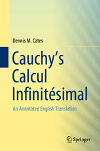- About MAA
- Membership
- MAA Publications
- Periodicals
- Blogs
- MAA Book Series
- MAA Press (an imprint of the AMS)
- MAA Notes
- MAA Reviews
- Mathematical Communication
- Information for Libraries
- Author Resources
- Advertise with MAA
- Meetings
- Competitions
- Programs
- Communities
- MAA Sections
- SIGMAA
- MAA Connect
- Students
- MAA Awards
- Awards Booklets
- Writing Awards
- Teaching Awards
- Service Awards
- Research Awards
- Lecture Awards
- Putnam Competition Individual and Team Winners
- D. E. Shaw Group AMC 8 Awards & Certificates
- Maryam Mirzakhani AMC 10 A Awards & Certificates
- Two Sigma AMC 10 B Awards & Certificates
- Jane Street AMC 12 A Awards & Certificates
- Akamai AMC 12 B Awards & Certificates
- High School Teachers
- News
You are here
Cauchy's Calcul Infinitésimal An Annotated English Translation

Publisher:
Springer
Publication Date:
2019
Number of Pages:
267
Format:
Hardcover
Price:
109.99
ISBN:
978-3-030-11035-2
Category:
Sourcebook
The Basic Library List Committee suggests that undergraduate mathematics libraries consider this book for acquisition.
[Reviewed by , on ]
Fernando Gouvea
05/19/2019
Several years ago I reviewed the first version of Dennis M. Cates’s translation of Cauchy’s notes on calculus. That version was a bare translation with very little in the way of notes. It was followed, about a year later, by A Guide to Cauchy’s Calculus, which provided a commentary on a selection of the lectures. We now have “An Annotated English Translation,” containing a revised version of the translation and many annotations in the form of footnotes.
Most of the comments on the original translation still apply: this is an important historical document, it is fun to read, and it is great to have a translation into English. I hope that the new publisher will give the book the wider audience it deserves.
The translation has been revised and is generally faithful to the original. As in every translation, there are some difficult choices to make. For example, in the sixth lecture, on applications of the derivative, we find (original and translation):
3.e Problème. Déterminer l’inclinaison d’une courbe en un point donné.Problem III. Determine the slope of a curve at a given point.
The word “slope” comes with the burden of a technical sense it has acquired in calculus and pre-calculus classes. It seems the correct choice only if “inclinaison” had this sense in French. Otherwise, I would have gone with “inclination” in English as well.
There are a few outright mistakes. For example (from the seventh lecture), \(\frac{\infty}{\infty}\) is an indeterminate form, not an “indeterminant” form. (The French reads “forme indéterminée.”) Similarly (from the twenty-seventh lecture), “a function \(\varpi(x)\) that works to satisfy the equation \(\varpi'(x)=0\)” doesn’t sound like English and doesn’t really correspond to “une fonction \(\varpi(x)\) propre à vérifier l’équation \(\varpi'(x)=0\).”
The annotations are generally good. In lecture 27, for example, Cates uses a footnote to remind us that Cauchy defines “an arbitrary constant” to be a locally constant function. In lecture 8, he calls our attention to Cauchy’s proof of the mean value theorem, including his unnecessary assumption that the function is continuously differentiable. Those of us who teach calculus will note at once that the proof does not use “Rolle’s Theorem.”
Despite some minor problems, this book is a very welcome contribution. I will be using it as a source for student readings in my history of mathematics classes.
Fernando Q. Gouvêa is Carter Professor of Mathematics at Colby College and a former editor of MAA Reviews.
See the publisher's page.
- Log in to post comments




